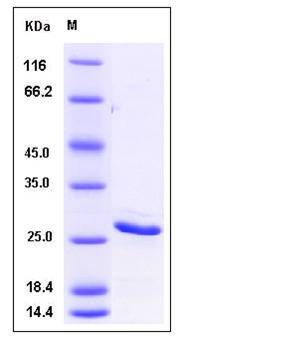Human BCL2 / Bcl-2 Protein (His Tag)
Bcl-2,PPP1R50
- 100ug (NPP3599) Please inquiry
| Catalog Number | P10195-H08E |
|---|---|
| Organism Species | Human |
| Host | E. coli |
| Synonyms | Bcl-2,PPP1R50 |
| Molecular Weight | The recombinant human BCL2 consisting of 221 amino acids and has a calculated molecular mass of 24.7 kDa. It migrates as an approximately 32 KDa band in SDS-PAGE under reducing conditions. |
| predicted N | Met 1 |
| SDS-PAGE |  |
| Purity | > 90 % as determined by SDS-PAGE |
| Protein Construction | A DNA sequence encoding the human BCL2 isoform 1 (P10415-) (Met 1-Asp 211) was expressed, with a polyhistide tag at the C-terminus. |
| Bio-activity | Measured by its binding ability in a functional ELISA. Immobilized human BCL2-His at 10 μg/ml (100 μl/well) can bind biotinylated mouse BCL2L1-His (P50012-M08E), The EC50 of biotinylated mouse BCL2L1-His (P50012-M08E) is 0.07-0.15 μg/ml. |
| Research Area | Signaling |Signal Transduction |Cellular Senescence and Pathways in Aging |Apoptosis |Intracellular |NF-kB (NFkB) Pathway | |
| Formulation | Lyophilized from sterile 50mM Tris, 20% glycerol, 100mM Arg, pH 8.5 1. Normally 5 % - 8 % trehalose, mannitol and 0.01% Tween80 are added as protectants before lyophilization. Specific concentrations are included in the hardcopy of COA. |
| Background | BCL2 (B-cell leukemia/lymphoma 2, N-Histidine-tagged), also known as Bcl-2, belongs to the Bcl-2 family. Bcl-2 family proteins regulate and contribute to programmed cell death or apoptosis. It is a large protein family and all members contain at least one of four BH (bcl-2 homology) domains. Certain members such as Bcl-2, Bcl-xl and Mcl1 are anti-apoptotic, whilst others are pro-apoptotic. Most Bcl-2 family members contain a C-terminal transmembrane domain that functions to target these proteins to the outer mitochondrial and other intracellular membranes. It is expressed in a variety of tissues. BCL2 blocks the apoptotic death of some cells such as lymphocytes. It also regulates cell death by controlling the mitochondrial membrane permeability and inhibits caspase activity either by preventing the release of cytochrome c from the mitochondria and/or by binding to the apoptosis-activating factor. Constitutive expression of BCL2, such as in the case of translocation of BCL2 to Ig heavy chain locus, is thought to be the cause of follicular lymphoma. Two transcript variants, produced by alternate splicing, differ in their C-terminal ends. |
| Reference |
